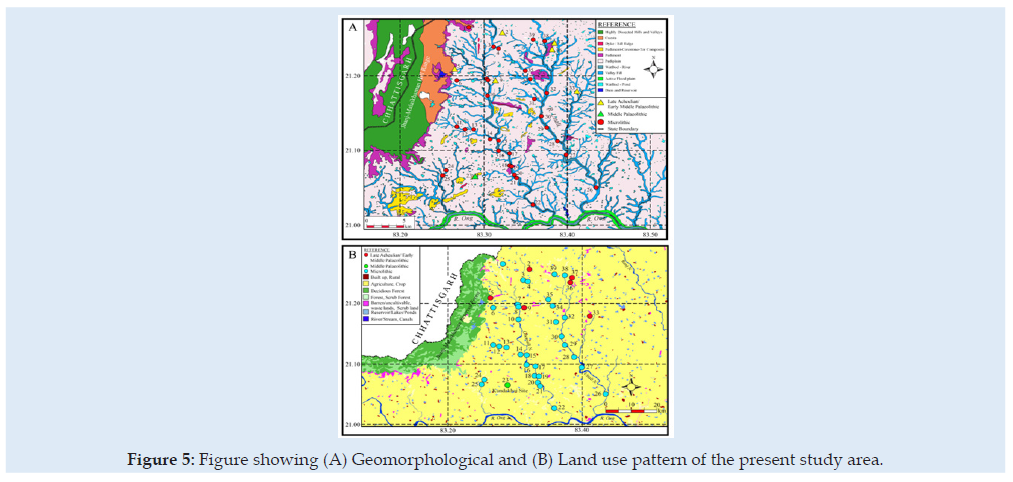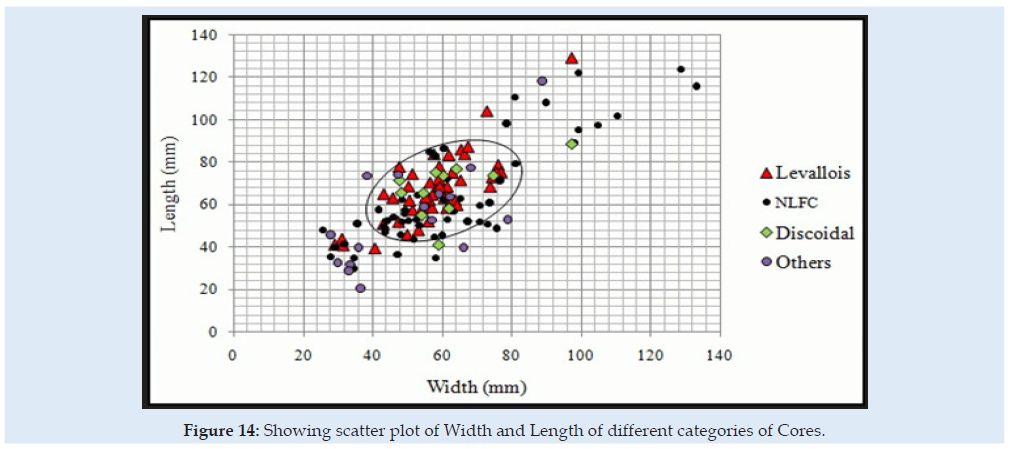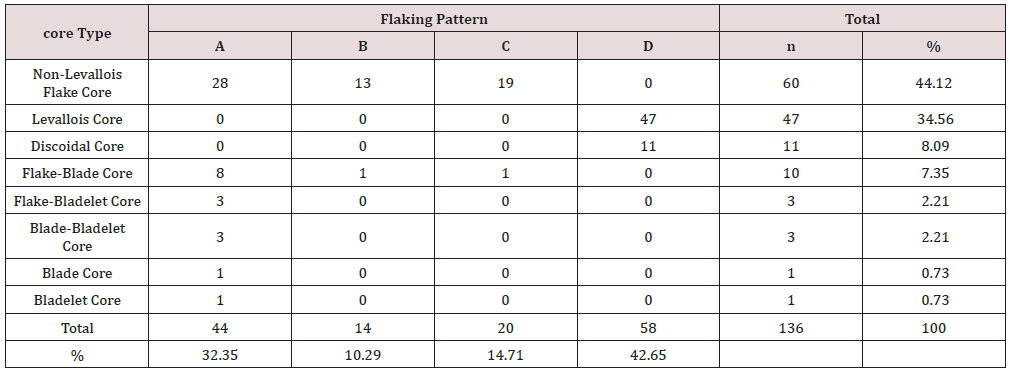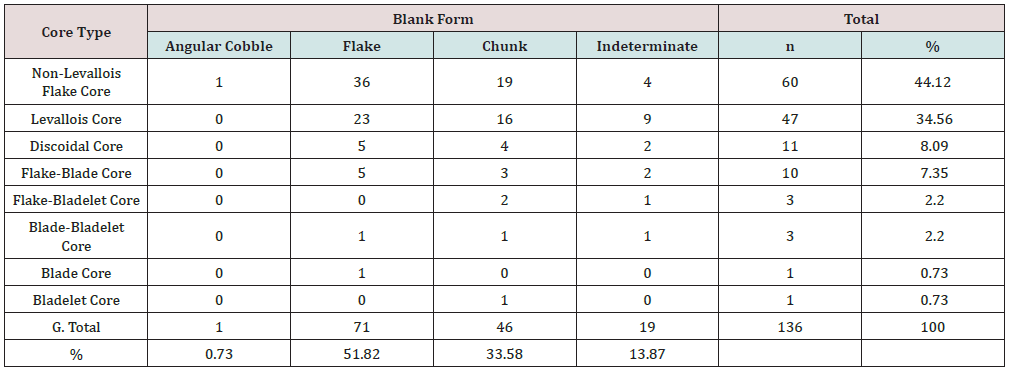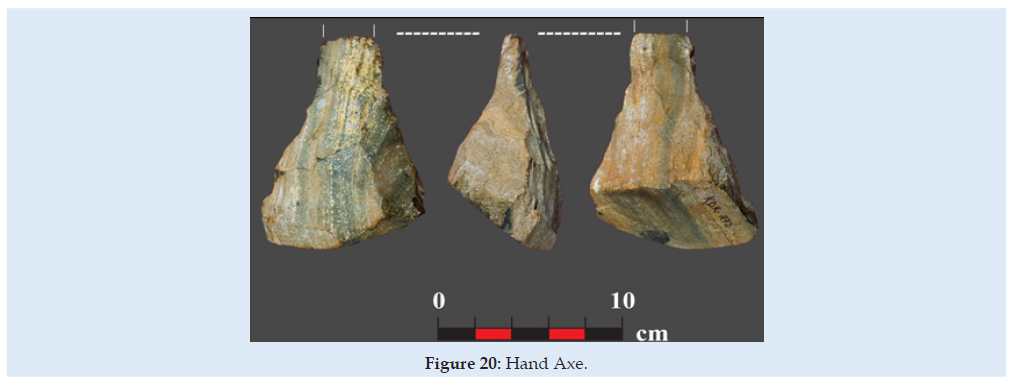
Lupine Publishers Group
Lupine Publishers
Menu
ISSN: 2690-5752
Research Article(ISSN: 2690-5752) 
Kundakhai: A Middle Palaeolithic Foothill Site in the Southern Bargarh Uplands, Odisha, India Volume 7 - Issue 1
Pradeep K Behera* and Kshirasindhu Barik*
- Pradeep K Behera and Kshirasindhu Barik, PG, Department of History, Sambalpur University, Odisha, India
Received:June 01, 2022; Published: July 13, 2022
Corresponding author: Tara Steimer Herbet, Laboratory of Prehistoric Archaeology and Anthropology, F.A. Forel Department for Environmental and Aquatic sciences, University of Geneva, Switzerland
DOI: 10.32474/JAAS.2022.07.000253
Abstract
The present report is the result of our intensive investigation conducted in the southern part of the Bargarh upland, Odisha with particular reference to an inselberg located close to the village of Kundakhai. The most interesting aspect of the lithic assemblage recovered from this site is represented by a pre-dominance of Levallois elements which include cores, flakes and a very few blades and bladelets, and a solitary example of a semi-finished hand axe of chert, and two heavily rolled quartzite used hammers, imported most probably from the Ong River valley which is located about 8 kilometers south of the Kundakhai site. Except the two hammers and the semi-finished hand axe seem to be imported from nearby sources located within a radius of about 8 kilometers, all other artefacts recovered from this site are made on silicified rock. In the near absence of blades and bladelets the assemblage recovered from the site is predominantly flake-based, which are exclusively made on locally available rock source. In terms of raw material use and other aspects, the studied assemblage completely differs from the Middle Palaeolithic sites widely distributed in the upper Jira River valley of the northern part of the Bargarh uplands, where artefacts are mostly made on medium-fine grained quartzite, abundantly available in the Debrigarh-Lohara masiff, thus showing Middle Palaeolithic assemblage variability in the studied region.
Keywords: Middle Palaeolithic; Levallois Technology; Silicified Stone; On-Site Exploitation of Raw Material
Introduction
The Middle Palaeolithic is often considered crucial in understanding the dynamics of spatiotemporal evolutionary changes, typified by the appearance of complex socio-cultural behaviour and adaptive strategies of modern humans in the archaeological context. In case of the Indian subcontinent, this cultural phase is of immense significance as it involves hotly debated issues pertaining to timing and dispersal of anatomically modern humans out of Africa and subsequent colonization of South Asia [1-7]. Numerous sites, both from stratified and surface contexts, attributed to the Middle Palaeolithic have been investigated across South Asia from diverse physiographic settings [8-18]. The available scientific dates from several stratified sites clearly suggest a long-time frame, i.e., about >350-40 ka, for the development of this culture in the region. From the point of view of geochronology and techno-morphological aspects of lithic industries, three broad developmental stages within this culture, viz., early, middle and late phases, have also been suggested [15].
Compared to other parts of the Indian subcontinent, evidence for a Middle Palaeolithic phase in the state of Odisha, was not known prior to the late fifties-sixties of the last century. For the first time Mohapatra reported lithic artefacts of Middle Stone Age from the finer gravel or Gravel-II, overlying Early Stone Age implementiferous layer from three major drainage systems, viz., the Brahmani, the Baitarani and the Subarnarekha, flowing through the districts of Sundargarh, Dhenkanal, Keonjhar and Mayurbhanj of northern Odisha, respectively [19]. Subsequently, preliminary exploration carried out by K.C. Tripathy in the south-western part [20]; A.K. Ghosh [21], D.K. Chakrabarti and R.K. Chattopadhyay [22,23] in Mayurbhanj and Keonjhar districts; and S.N. Ratha (IAR 1983-84: 64-66) in Sambalpur district of Odisha, have brought to light some stray lithic artefacts from secondary contexts, technotypologically assignable to the Middle Palaeolithic phase. Although these pioneering discoveries made during the latter half of the twentieth century succeeded to some extent in establishing the Middle Palaeolithic potential of Odisha, the prospect of further research on this cultural phase in the region virtually faded away for a long span of time. As a result, till recently very little is known of the spatiotemporal contexts and cultural characteristics of the Middle Palaeolithic phase in Odisha. In view of above the recent investigation conducted at the foothill site of Kundakhai (Figure 1&2) becomes significant.
Figure 1: Location of the Kundakhai Middle Palaeolithic site in India (Courtesy: Google Satellite Image).
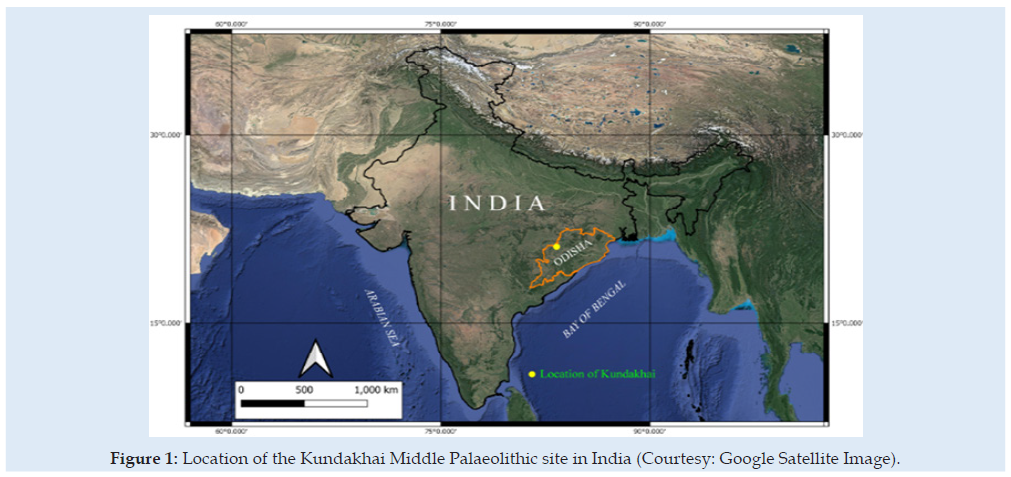
Figure 2: Topographic Map of the Northern Bargarh upland showing distribution of Late Acheulian-Middle Palaeolithic sites on the southern flank of the Debrigarh-Lohara massiff in the upper Jira valley.

During the last decade, several seasons intensive field investigation carried out in the northern part of the Bargarh uplands of western Odisha have brought to light a large number of Late Acheulian-Middle Palaeolithic sites (Figure 3) in primary/ semi-primary stratified contexts in the upper reach of the river Jira and its tributary Danta [24,25]. These sites have been found to be distributed within a radius of 20-25 kilometers south of the Debrigarh-Lohara massif, which forms the major primary source of raw materials, viz., different grades of quartzite, chert and vein quartz, used extensively for lithic artefact manufacture by the Palaeolithic hominins in the region [24]. In order to assess the spatial distribution of such sites, intensive exploration was also conducted in the south-western part of Bargarh uplands (Figure 4), which resulted in the discovery of a few Lower and Middle Palaeolithic sites and a large number of microlithic sites with flakes, blades-bladelets and geometric elements (Figure 5), suggesting persistence of Middle-Late Pleistocene hominin in the Bargarh uplands. One of the important sites documented during this investigation was Kundakhai, associated with a distinct assemblage of Middle Palaeolithic culture located at the source of raw material, in the foothill context of an inselberg, a preliminary observation on which is presented below.
Figure 3: Area showing the present Investigation of Study in the Southern part of Bargrh upland in the middle course of the river Ong.
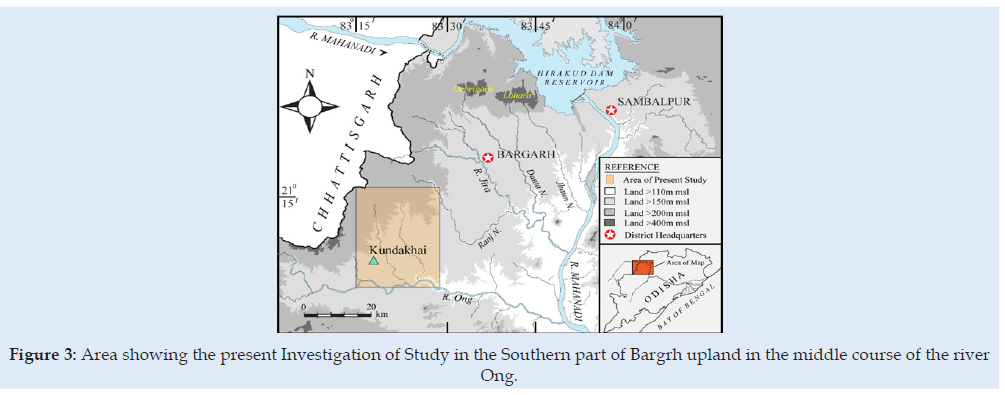
Figure 4: Distribution of Palaeolithic and Microlithic Sites in two major tributaries of the river Ong in the study area.
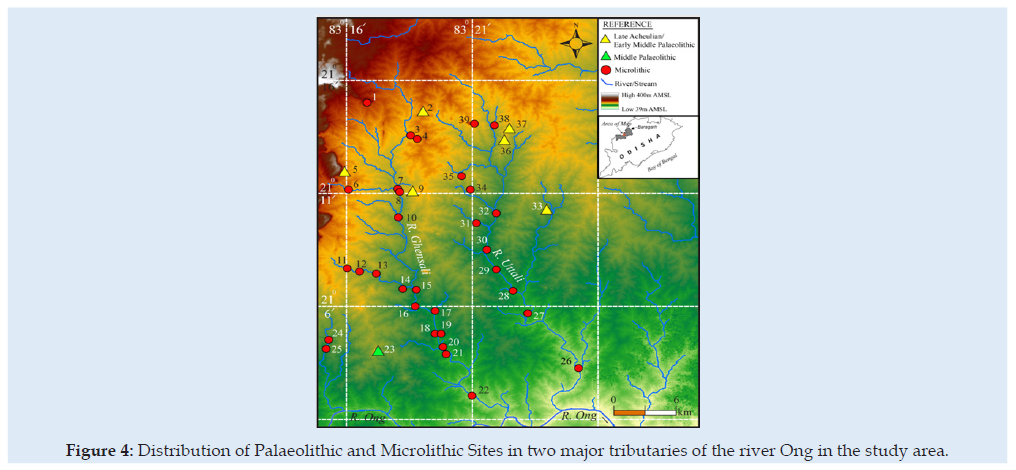
The Area and Its Environmental Setting
The area under study is situated south of the Jira River system and covers largely the Topographic sheet No. 64 O/4 & O/8, and 64 P/1 & P/5 of the Survey of India. The area is mainly drained by the river Ong and its two major tributaries, viz., Ghensali and Utali, which originate from the Jhanj-Malaikhaman hilly range lying west of the area of study. The drainage pattern is mainly dendritic and controlled by the perennial Ong River, which meanders in an easterly direction by following the topographic slope. The tributaries are seasonal and carry water during the monsoon only (Figure 6). The general slope of the area represents gently undulating pedimented surface towards south-southeast with an average elevation of 198m amsl, intervened here and thereby a number of inselbergs and widely scattered rocky outcrops in the form of residual humps, very often seen on the riverbanks, agricultural fields, and forested areas. While the cultivated land constitutes a substantial portion of the surface of this area, the fallow and forest areas have irregular patches of tropical dry-deciduous type of thick vegetation cover with shrubby undergrowth extending over considerable distance on the top, slope and intermontane areas of the Jhanj-Malaikhaman hill range. The forested areas form the veritable abode of a wide variety of large and small wild carnivores and ungulates. The area receives annual average precipitation ranges between 20cm and 25cm with a maximum temperature of 45°C during summer and 10°-12°C in winter seasons (Senapati and Mahanty 1971).
Geologically the area forms a part of the great Peninsular Shield, and the rock formations belong to the Archaean system of pre-Cambrian age. The younger formations constitute the Recent to Sub-Recent weathering products of older rocks represented by the laterite, river in ealluvium, and soil. Within the Achaeans, three distinct rock formations have been found, viz.
a) Sedimentary meta morphites represented by quartz-mica schist and phyllite.
b) Meta-basites represented by hornblende schist, amphibolites andepidiorite, and
c) Granitoid rocks
• The granitoid varieties are divisible into two separate groups:
a) Biotite granodiorite and
b) Migmatitic gneisses, which include the porphyroblastic gneiss, banded gneiss, and the ‘augen’ gneiss.
The representatives of the first group are generally devoid of foliation, whereas those of the second group exhibit gneissose in various degrees of development. At places, veining of the gneisses by the granitic material has been reported [26]. The granitoid varieties have been invaded by dykes of dolerite and thin quartz and pegmatite veins (Figure 7). The stratigraphic succession of the lithologic units found in this area is given in Table 1.
Figure 7: Figure showing a closer view of the site of Kundakhai (A) Google Earth image, (B) its topographic features and land elevation.
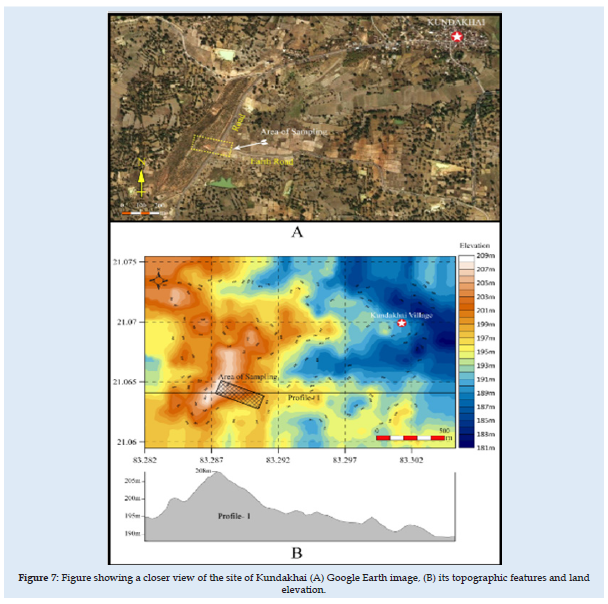
The Site
The site (21.064299 N and 83.288727 E, elevation: 204m amsl) is located on the eastern flank of the foothill slope of an elongatedoval shaped low inselberg, oriented northeast-southwest, and situated about one and a half kilometer southwest of the village Kundakhai (21.069718 N and 83.300614 E, elevation: 191m amsl), and about sixty kilometers southwest of the district headquarters of Bargarh. The inselberg rises to a maximum height of about 217m above mean sea level (Figure 8), the peripheral area of which is surrounded on all sides by cultivated farmlands, except a small patch of eroded surface of about 100m2lying almost at the middle portion of the foothill. Except for this patch, no other locality in and around the inselberg yielded any evidence for hominin activity. The primary context of the site is greatly disturbed with the construction of two roads, one, five meters wide coal tar road running all along the periphery of the foothill on the western flank which connects the village Kundakhai with the sub-divisional headquarters of Padampur, and another earth road running almost east- west and joining the main road at the site. Construction of these roads must have wiped out at least a substantial portion of the site. Despite anthropogenic interventions, a dense scatter of Middle Palaeolithic artefacts showing fresh physical conditions with moderate patination and abrasion was found near the junction of the two roads. Here artefacts were found interspersed within a deposit of coarse angular/sub-angular rubbles/cobbles of silicified rock in a residual lateritic matrix (Figure 9). Stratigraphically, the implementiferous cobbly-lateritic deposit overlies a thick layer of secondary laterite with sparse distribution of rock fragments, as evident from a section exposed during the construction of the roads, on the western flank of the foothill (Figure 10).
Figure 8: Artefact scatters found on the foothill of the sampled area of the Kundakhai hill. Here some of the artefacts are found embedded in a deposit of coarse clast in a lateritic matrix.
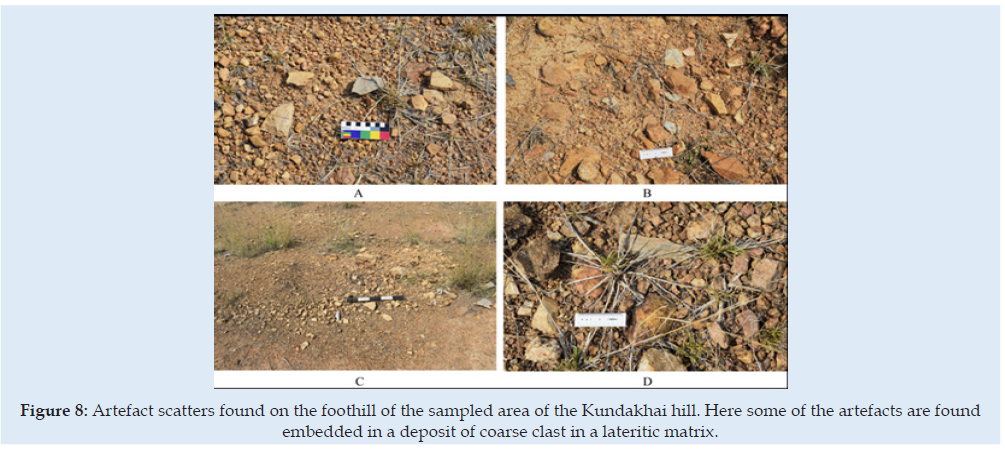
Figure 9: An exposed section on the southern flank of the Kundakhai hill showing artefacts embedded in matrix of secondary laterite with coarse clast/hill cobbles.
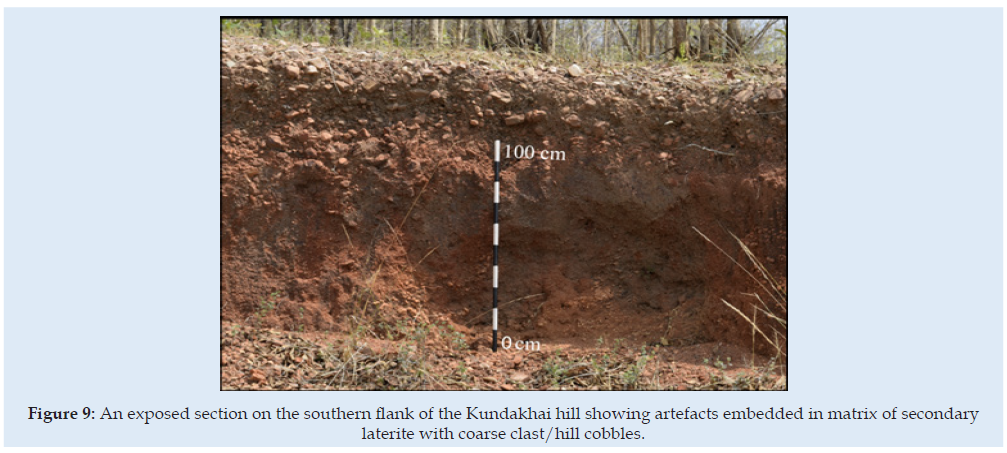
Figure 10: A view of the top of the Kundakhai hill with exposed bedrocks of huge, silicified boulders.
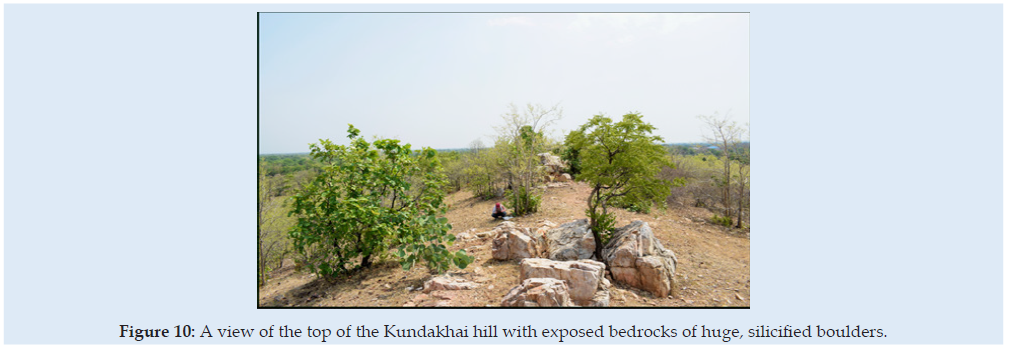
With sparse vegetation cover, the hill is mainly composed of dykes of silicified rocks which intruded into the granitoid parent rocks. Huge boulder-blocks of this rock and their weathering products are noticed on the top of the hill (Figure 11), the surface of which also yielded a few artefacts. Within the site complex, artefacts were found in varying distribution patterns (Table 2), highest density on the foothill area (93.73%), while scattered pieces on the middle of the hill slope (3.02%) and on the top of the hill near the silicified outcrops (3.25%), suggesting preference for foothill zone for lithic knapping and other activities than the other two loci. Investigation at the site involved a thorough survey by field walking method assisted by a handheld Garmin Etrex-10 GPS (resolution<3m), mapping (topographic and artefact distribution), and collection of exposed artefacts for detailed attribute analysis. Artefacts were collected from an area measuring 100m x 250m, covering the maximum exposed scatter from the western foothill slope to the top of the hill.
Figure 11: A closer view of some of the silicified bedrocks on the top of the hill showing removal of large flakes with hard hammer percussion.
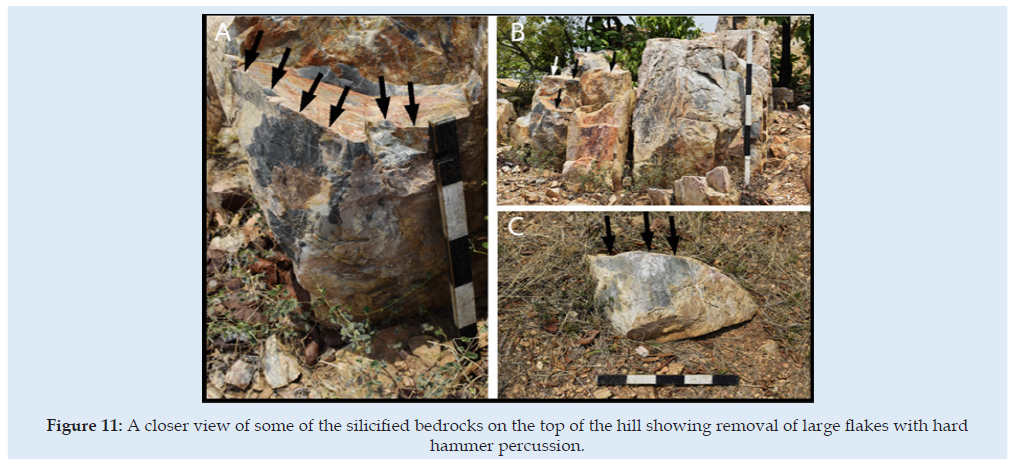
Lithic Assemblage Composition
The area delineated for artefact collection yielded a total of 862 artefacts (Table 3), represented by cores showing different stages of reduction (15.87%), debitage (32.67%), shaped tools including six on core and a solitary hand axe (15.41%), hammers with battering marks (0.23%) and manufacturing waste (35.80%). The overall assemblage composition clearly indicates that flakes not only dominate the debitage class, but a large majority of the shaped tool category has also been made on them. Except the hilltop context, artefacts collected from the hill-slope and foothill loci are uniformly thin patinated and moderately abraded, and often bear patches of ferruginous stain and/or encrustation on their surface, indicating their depositional context. Despite the slope of the hill and recent anthropogenic interventions, the majority of the artefacts recovered are in good physical condition. Of a total of 113 broken specimens in flakes, blades and bladelets (Table 4), 39.82% are distally broken, followed by tip breakage (37.17%), proximal (15.04) and lateral (7.96%). Only three of the 137 available cores are distally broken. Besides knapping and raw material flaws, breakage on artefacts might have occurred due to the displacement of artefacts from their primary contexts during post-depositional slope-erosion process.
Raw Material Use
The relative abundance of raw material types in an assemblage, besides geographic distance from the source and the forms in which they were transported to the activity area, often provide valuable evidence for understanding organization of Palaeolithic adaptive strategies [27-32]. At Kundakhai, of the four types of raw material, an overwhelming majority of the artefacts are made on silicified rock, while only a small number of artefacts on milky quartz, chert and quartzite (Table 5). Outcrops of silicified dyke are noticed on the top of the inselberg, some of which bear bold marks of hardhammer percussion on their surface (Figure 12), suggesting onsite quarry activities. Besides quarrying of the outcrops, angular/ sub-angular cobbles of this rock, abundantly found scattered on the slope of the inselberg, were also largely utilized for blank production at the site.
Figure 12: Figure showing different Levallois core from the sampled area-Recurrent Levallois Core (1-4), Preferential Levallois Core (5-6), Discoidal Core (7-8).
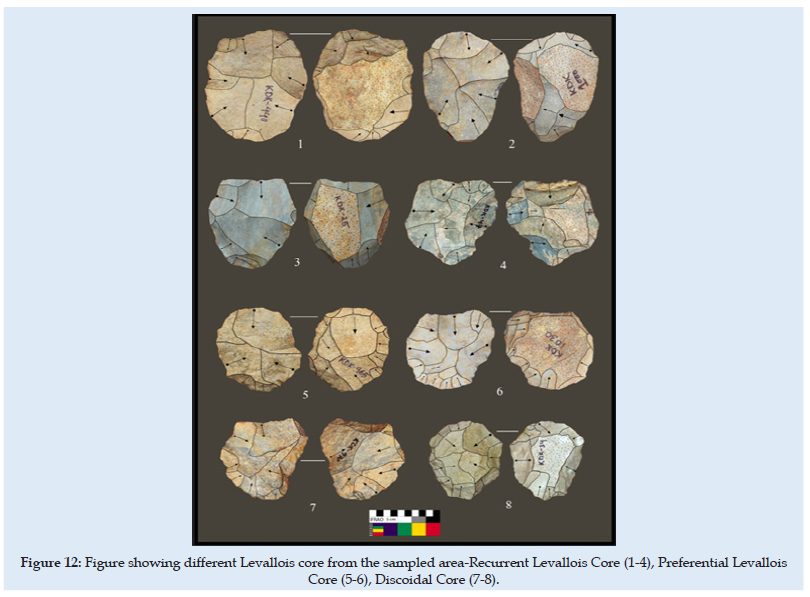
Probably, abundance, knapping quality of the rock, and costeffective procurement of this raw material at the site might have prompted the Middle Palaeolithic hominins for temporary/seasonal occupation of this locality. Raw materials other than silicified stone, namely quartzite, chert, and milky quartz, constitute little more than 6% in the assemblage. The nearest source of quartzite is the gravel bed of the river Ong, which flows some 7-8 kilometers south of the site. The two heavily rolled hammers of quartzite, one complete and another longitudinally broken half were brought to the site most likely from the gravel sheet of the Ong. Chert was probably procured from the upstream channel beds of the Ghensali and Utali, the two major tributaries of the Ong. Both the streams originate from the eastern flank of the Jhanj-Malaikhaman massif. The channel bed near the source of these streams are found to be very rich in slightly rolled and patinated angular/sub-angular pebbles/ cobbles of chert, closely similar in colour and texture to those found in the Kundakhai assemblage. Exposed veins of quartz are noticed at several places nearby the site. Thus, all the raw materials utilized at Kundakhai were available in the lithic land scape [33] within a maximum range of about 20-25 kilometers from the site. However, patterns of raw material used at the site appears to have been focused primarily on the exploitation of primary source onsite, i.e., silicified rock, rather than procuring raw materials from distant sources.
Core Technology
With a view to understanding blank detaching techniques adopted at the site, the available cores and debitage were subjected to morphometric analysis in relation to their blank forms, scar patterns, and techniques employed for blank removals, etc. Based on the above, broadly eight different types of cores could be identified, namely Levallois core, discoidal core (Figure 13), non-Levallois flake core (NLFC), flake-blade core, flake-bladelet core, (Figure 14) blade-bladelet core, blade core and bladelet core (Table 6). Although there are a few atypical blade-bladelet cores, most of the cores were intended for flake blank production, as is evident from a clear predominance of flake scars on the blank removal surface of different types of cores, including Levallois and discoidal. In the Levallois group, the majorities are of recurrent types (87.23%), and only a few are represented by preferential type (12.77%). Majority of the cores of this assemblage are broad to ovaloid in shape and thin in comparison to their maximum width, which might be due to high intensity in core reduction strategy (Figure 15). While there is a wide range of size variability among the cores, the width/length ratio of Levallois cores are highly symmetrical as compared to others (Figure 16). In the case of Levallois cores, the back surface is mostly flattish with the remnant surface of the original blank form and bears marks of prepared platforms all around, while the dorsal surface retains the typical convexity with centripetal negative scars. As procurement of raw materials from alluvial sources was probably deliberately avoided, in majority of the cases, thick flakes (51.82%) and thick chunks/flaked shatters (33.58%) of silicified rock were utilized as cores (Table 7).
Figure 13: Figure showing different non-Levallois core from the sampled area-Flake/Blade Core Single Platform (1), Opposed Platform Opposite Face Flake Core (2), Single Platform blade & Bladelet Core (3), Single platform Flake Core (4).
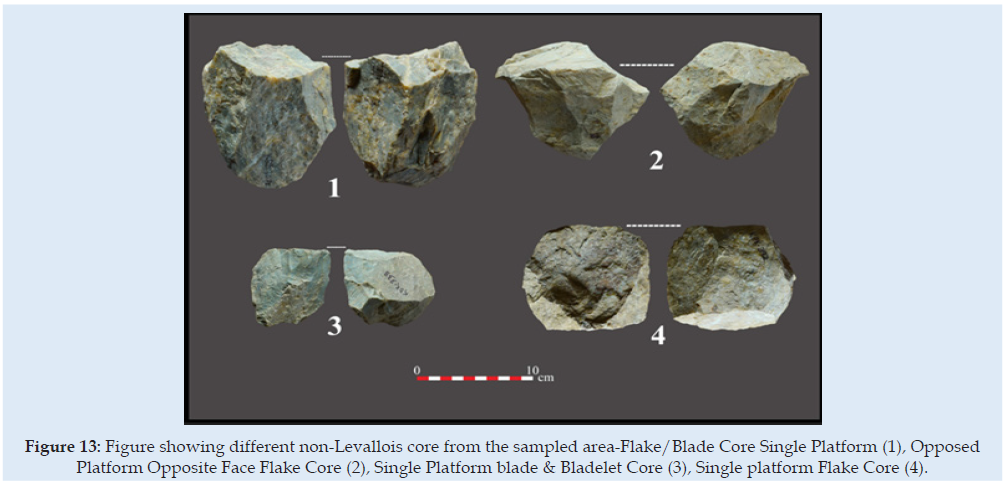
A: Single platform, B: Opposed platform same face, C: Opposed platform opposite face, D: Centripetal.
Figure 15: Showing box-plot width/length ratio of different categories of Cores from the site with their Means. The figure shows width/length ratio of Levallois cores are highly symmetrical as compared to others.

Figure 16: Scatter plot clearly indicates majority of the sampled cores are broad/ovaloid shaped and measure less than 300gm in weight.

Cores with rounded cortical surface are totally absent in the assemblage, suggesting no preference for raw materials, like pebbles/cobbles from alluvial sources. From the point of view of number and location of striking platforms, except Levallois and discoidal cores, in all other cases (78) cores are mostly single platformed (32.12%), followed by opposed platform opposite face (14.6%) and opposed platform same face (10.22%). Platforms are mostly prepared unfaceted (74.36%), besides faceted (19.23%) and cortical type (6.41%). The blank removal surface in most of the cores show feather termination (35.04%) or feather and step terminations (36.5%), besides feather and hinged (13.87%), and hinged (7.3%). During the process of reduction, rejuvenation of platforms and blank removal surface of cores was carried out as evident from the occurrence of corresponding core-rejuvenating flakes and a few blades in the assemblage. The majority of the sampled cores are broad/ovaloid shaped and measure less than 300gm in weight (Figure 17).
Figure 17: The scatter plot clearly indicates that in size the available flakes are mostly represented by low elongation and moderately thick.

Debitage
The group of unmodified blanks comprises flakes (197), blades (20), and bladelets (2), in which broken artefacts account for 29.89% with 77.38% breakage occurs on the distal and tip portion of the blanks (Table 8). As fresh breakage is rare, majority of the blanks seems to have been broken during the course of their removal from the respective cores or during the subsequent postdepositional erosional process. While blanks with fully cortical dorsal surface and platform (first flakes/blades detached from unprepared core/raw material) are rarely represented (2.03%), the large majority represents Toth’s ‘Flake Type-VI’, i.e., noncortical dorsal and prepared platform [34]. Most of the other types of flakes, i.e., those with cortical/non-cortical platform and partly cortical dorsal surface (Toth’s Type II-V) appear to have been detached during the course of preparation of platform and blank removal surface of the cores. In size the available flakes are mostly represented by low elongation and moderately thick (Figure 18). The length and width of majority of the Levallois (57.14%) and non-Levallois flakes (76.16%) vary from 40-60mm and 20-50mm, respectively, whereas none of the flakes measures more than 90mm in length. Presumably, large and thick flakes quarried from the outcrops on the hilltop were utilized as cores for blank production, as is indicated from a high percentage (51.82%) of cores made on flake blanks. Platforms are mostly prepared unfaceted (44.79%), followed by faceted (23.44%), dihedral (8.33%), and punctiform (2.6%). Interestingly, a large majority of the core samples (74.36%) demonstrates unfaceted prepared platforms. Except Levallois, 10.42% of the debitage exhibit cortical platform, and only one Levallois flake has lipped platform, whereas 9.9% of platforms are either crushed or very thin for any metrical observation (Table 9).
Figure 18: Different types of tools made on Silicified stone, 1-Side Scrapper, 2-Levallois Point, 3-Denticulate, 4-Concave Side Scrapper, 5-7 & 9-11 Blades (5-Offset Dihedral Burin, 7- Partially baked & Unilaterally Retouched on Ventral Side, 8- Bladelet, 9-11 Partially retouched Lateral).
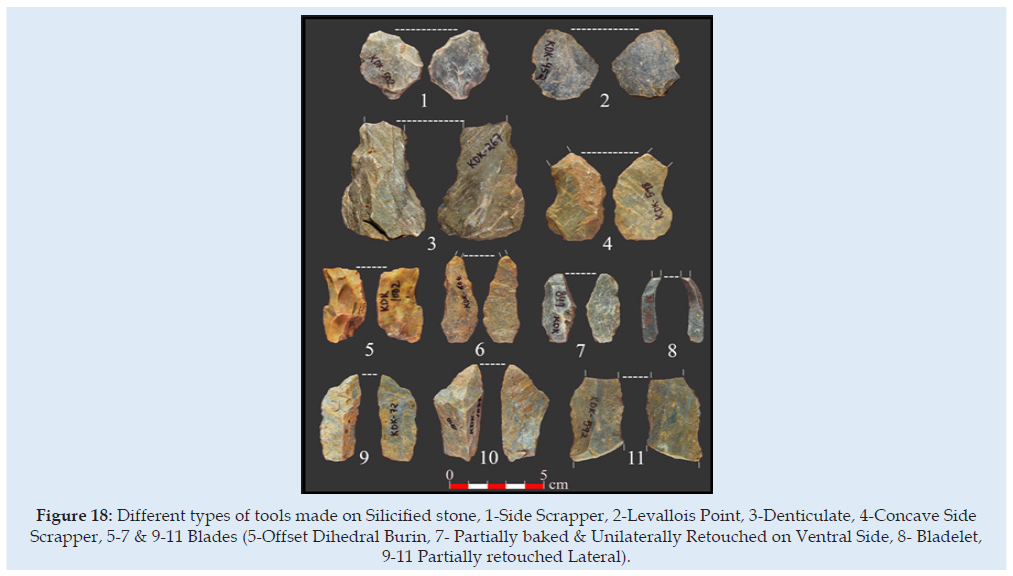
The Table 9 clearly shows wide variability in platform size, area (expressed as: platform width x thickness) and relative platform size (expressed as: debitage width x length/platform width x thickness) in different debitage types, suggesting thereby that platforms of the cores were cleverly manipulated as per desired end products. In most of the cases, platforms are generally thin in relation to width and the relative platform size is greater in blades than flakes. Of a total of 181 complete unretouched flakes, including Levallois, nearly 70% of the bulbs are pronounced exhibiting typical irrailure fracture on them (34.81%), indicating frequent use of hard hammer percussion method for blank production. Except Levallois, the dorsal scar pattern on flakes is dominantly unidirectional (58.38%), majority from proximal end, followed by bidirectional scars originating from both the ends (15.74%). Compared to other types of flakes, those with bidirectional scars are also relatively thick. There are two Kombewa flakes in the debitage group and two others in the shaped tool category, though the assemblage lack evidence for Kombewa core.
Shaped Tools
The tool class includes a wide variety of artefacts showing secondary modifications of debitage, besides a few cores and a partially finished hand axe (Table 10). Of a total of 139 shaped tools, excluding the hand axe, an overwhelming majority (70.50%) are made on non-Levallois flakes, whereas only 15.82% on Levallois flakes. In the non-Levallois category, about 44% exhibit secondary modifications on flakes bearing unidirectional scars on the dorsal surface. Our study reveals that there was no specific size preference for blanks to be modified into different type of tools. Rather it appears blanks were probably randomly selected for tool modification as per suitability and requirements. The assemblage contains a high percentage of various types of scrapers, particularly side variety, besides notches and denticulates (Figure 19). They account for more than 61% and constitute the representative tool class at the site. Retouch marks in case of scrapers are mostly semiinvasive and appear in majority of the cases on the dorsal surface of the blanks. There are a few transverse and end scrapers in the assemblage. The later types mostly appear on cores and blades, though they lack the typical lamellar form of removals. In the case of notched tools, the individual notches are mostly meticulously retouched, though there are also a few examples of Clactonian types of notches.
Figure 19: 1-Pseudo Levallois Tanged point, 2-Levallois Point, 3-Transverse Scrapper. 4-8 - Levallois Flake, 9- Non Levallois Bidirectional Flake.
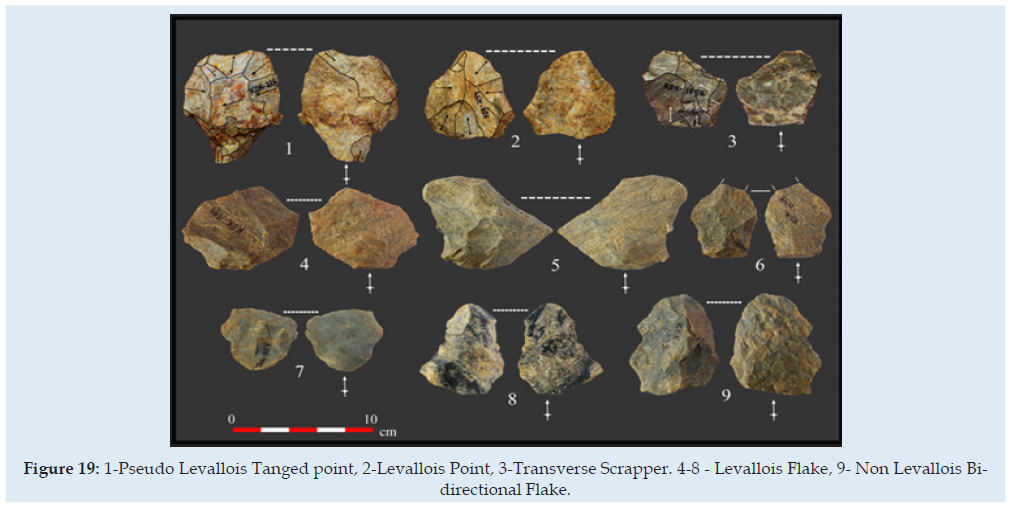
In case of awls, they mostly appear on the distal-lateral side with marks of retouching on both sides. Burins are represented by both axial and offset types, besides a few transverse varieties. They also occur in combination with other tool types like scrapers and notches. There are few points in the collection, mostly represented by typical as well as atypical Levallois points, besides a bilaterally retouched point and a tanged point (Figure 20). In the latter case while the tang is bilaterally prepared, the distal end is not convergent, as in case of typical tanged points reported from several Indian Middle Palaeolithic assemblages [9,35] including Bargarh upland [25]. Except one example of partially backed blade, the assemblage in general lacks backed tools.
The only handaxe from the site is made from sub-angular clast of grayish-black chert with unmodified butt and broken tip (Figure 21). As pointed out earlier, the nearest source of such chert lies in the upstream of the Ghensali and Utali streams rising from the Jhanj- Malaikhaman hill rage. The specimen, measuring 119.83mm in length, 83.25mm in width and 50.68mm in thickness and weighing 383gm, is bifacially prepared with invasive to semi-invasive broad scars from both the lateral sides. The unmodified butt retaining the original flat surface of the raw material is thick and wide, while the distal tapering end is flattish and thin with broken tip. The medial cross-section of the specimen is roughly rhomboidal in shape with raised mid ridge on both the surface. Though comparatively fresh, the specimen is moderately patinated and abraded. Overall, the working on the handaxe is essentially crude. From the available evidence it is difficult to suggest whether the specimen was imported to the site in semi-finished stage from some other locality or manufactured at the site itself. Except this biface no other heavyduty tools have been found in and around the site.
Concluding Remarks
Within the limitations of the present investigation, some significant observations may be made with regard to the general characteristic features of the analyzed lithic assemblagere covered from the foothill site of Kundakhai. As stated earlier, in the northern sector of the Bargarh uplands, drained by the river Jira and its several perennial, quasi-perennial and ephemeral streams of different orders have brought to light a large number of localities with evidence for Late Acheulian-Middle Palaeolithic open-air sites, which are distributed within a range of 5-10 kilometers from the southern flanks of Debrigarh-Lohara mass if [24]. One of these localities, namely Torajunga, has yielded extensive remains of early Middle Palaeolithic assemblage characterised by small to medium-sized bifaces (handaxes and cleavers), different types of scrapers, notched tools, denticulates, spheroids, etc., besides well-made tanged points in a stratified deposit of fine rubbles in lateritic matrix [25]. More or less similar stratigraphic context and lithic assemblage composition have been observed at almost all other localities in the northern sector of the Bargarh upland where quartzite remains the predominant raw material utilized in lithic production as the source of this raw material lies in the Debrigarh- Lohara massif which is located within a range of 5-10 kilometers from the Palaeolithic localities. Except Torajunga, in almost all the discovered localities in this area artefact of Late Acheulian-Middle Palaeolithic are found in mixed condition on exposed eroded surface. Abundance of raw materials suitable for manufacturing large cutting tools (LCT) and other tool types, perennial water sources and varied geo-ecological environments might have played a very significant role in early Palaeolithic settlements in this part of the Bargarh uplands.
As noted earlier, with a view to tracing the extension of Late Acheulian-Middle Palaeolithic sitesan intensive survey was conducted further south of the Jira river valley, in the Padampur subdivision of the Bargarh district, which is mainly drained by the middle segment of the river Ong and its major perennial tributaries like Ghensali and Utali, besides several seasonal and ephemeral streams, originating from the Jhanj-Malaikhaman massif, lying towards the west of the area of the present study. Our investigation in this area brought to light a large number of localities bearing dense to thin scatters of flake-blade/microlithic assemblages from different geo-ecological contexts. It was also noticed that in comparison to the above category of sites, there are only few sporadic occurrences of early Palaeolithic artefacts, mostly close to the foothill area of Malaikhaman hill range. During the course of our investigation, we recorded several primary as well as secondary sources of a variety of chert, particularly in the upper course of the Ghensali and Utali streams, besides a large number of quartz veins. However, we failed to locate any primary or secondary source of quartzite, as has been extensively recorded in the Debrigarh- Lohara massif in the upper catchment of the Jira River system. Notwithstanding any marked difference in the environmental contexts of both the northern and southern sectors of the Bargarh uplands, probably due to the scarcity or near absence of quartzite, evidence for early Palaeolithic settlement sparsely occur and sporadic in the present study area. Thus, from the point of view of raw material exploitation and use, the site of Kundakhai widely differs from those located in the northern sector of the Bargarh upland. On-site exploitation of primary raw material like silicified rock outcrops and colluvial clasts for lithic reduction remains the basic feature of the Kundakhai site, though a few extraneous raw materials like two quartzite hammers and chert (2.36%) artefacts including the semi-finished hand axe were procured from within a radius of about twenty kilometers from the site.
From the point of view of techno-typology and other counts, while the Kundakhai assemblage largely differs from those of the Jira valley, like absence of small to medium sized hand axes and cleavers, picks, polyhedrons, well-organized blade core technology, well-made tanged points, etc., the site under discussion also shares many common characteristic features with the Jira valley assemblages like, wide use of preferential as well as recurrent Levallois technique, discoids, predominance of scrapers, notched tools and denticulates, which normally found in majority of the Middle Palaeolithic industries of the Indian sub-continent [35]. Significantly, chopper-chopping tools, which occur in many Indian Middle Palaeolithic sites, like in the Soan valley (Late Sohan-A), the Dang-Deokhuri Dun valleys in Nepal [36], Budha Pushkar area in Rajasthan [37], several sites in southern Uttar Pradesh [38-40], Patpara II in the Son river valley [41] and Adamgarh [42] in central India, Jamalpur in Bihar [43,44], Kortallayar basin in Tamilnadu [45,46], Ramayogi Agraharam in Andhra Pradesh [47], Giddalur area in Kurnool district of Andhra Pradesh [48], Sagileru basin in the Cuddapah district in Andhra Pradesh [49], etc., are not represented in the Middle Palaeolithic industries of the Bargarh uplands [25], though there is abundance of pebbles-cobbles of different sizes in the channel beds of major-minor rivers and their tributaries in the region.
In the Indian context some scholars have tried to subdivide the Middle Palaeolithic industries into three developmental stages, like early phase with continuation of Acheulian elements, middle phase dominated by prepared core and discoidal core technology and the late phase with increasing use of blade technology [15]. Though phasination within the Middle Palaeolithic appears tenable, yet it lacks stratigraphic succession, and it is mainly based on techno-typological variability. At least from the point of view of techno-typology, the assemblage from Kundakhai foot hill site appears to represent the second phase of development within the Middle Palaeolithic, though at the present stage of research no chronological position can be assigned [50-54]. Nevertheless, our study clearly reveals variability in the use of raw material and assemblage composition within the Bargarh uplands of Odisha. The future course of investigation will be focused on spatiotemporal variability and cultural contexts of the Middle Palaeolithic settlements in the Bargarh uplands.
Acknowledgment
The authors are thankful to Archaeological Survey of India for giving permission to carried out the present investigation, and also thankful to the authorities of Sambalpur University. The authors are also thankful to Dr. Sakir Hussain for his help in photographic reproductions used in this paper.
References
- Kuhn SL (1995) Mousterian lithic technology: An ecological perspective. Princeton University Press, New Jersey, United States.
- Mellars P (2006) Why did modern human populations disperse from Africa ca. 60,000 years ago? A new model. Proceedings of the National Academy of Sciences of the United States of America 103(25): 9381-9386.
- Mellars P, Gori KC, Carr M, Soares PA, Richards MB (2013) Genetic and archaeological perspectives on the initial modern human colonization of southern Asia. Proceedings of the National Academy of Sciences of the United States of America 110(26): 10699-1070.
- Groucutt HS, Petraglia MD, Bailey G, Scerri EML, Parton A, et al. (2015) Rethinking the dispersal of Homo sapiens out of Africa. Evolutionary Anthropology 24(4): 149-164.
- Mishra S, Chauhan N, Singhvi AK (2013) Continuity of Microblade Technology in the Indian Subcontinent Since 45 ka: Implications for the Dispersal of Modern Humans. PLoS ONE 8(7): 1-14.
- Korisettar R (2015) Antiquity of Modern Humans and Behavioural modernity in the Indian Subcontinent: Implication of the Jwlalapuram evidence. Emergence and diversity of Human behaviour in Palaeolithic Asia (Y Kaifu, M Izuho, T Gobel, H Sato, A Ono Ed) Texas A&M University, US State p. 1-51.
- Petraglia M, R Korisettar, N Boivin, C Clarkson, P Ditchfield, et al. (2007) Middle Paleolithic Assemblages from the Indian Subcontinent before and after the Toba Super‐ Eruption. Science 317(5834): 114-116.
- Petraglia M, J Schuldenrein, R Korisettar (2002) Landscapes, activity, and the Acheulean to Middle Paleolithic transition in the Kaladgi Basin, India. Eurasian Prehistory 1(2): 3‐24.
- Petraglia M, R Korisettar, M Noll, J Schuldenrein (2003) An Extensive Middle Palaeolithic Quarry Landscape in the Kaladgi Basin, Southern India, Antiquity. Project Gallery 77(295): 1‐5.
- Ajithprasad P (2005) Early Middle Palaeolithic: A Transition Phase between the upper Acheulian and the middle Palaeolithic Cultures in the Orsang Valley, Gujarat. Man and Environment 30(2): 1‐11.
- Haslam M, C Clarkson, M Petraglia, R Korisettar, J Bora, et al. (2010a) Indian lithic technology prior to the 74,000 BP Toba super‐eruption: searching for an early modern human signature. The Upper Palaeolithic Revolution in Global Perspective: Essays in Honour of Paul Mellars, Boyle K, C Gamble, O Bar Yosef (Eds.), McDonald Institute for Archaeological Research, Cambridge, USA pp. 73-84.
- Haslam M, C Clarkson, M Petraglia, R Korisettar, S Jones, et al. (2010b) The 74,000 BP Toba super‐eruption and southern Indian hominins: archaeology, lithic technology and environments at Jwalapuram Locality 3. Journal of Archaeological Science 37(1): 3370-3384.
- Blinkhom J, H Achyuthan, M Petraglia, P Ditchfield (2013) Middle Palaeolithic Occupation in the Thar Desert during the Upper Pleistocene: The Signature of a Modern Human Exit out of Africa? Quaternary Science Reviews 77(1): 233‐238.
- Blinkhorn J (2014) Late middle palaeolithic surface sites occurring on dated sediment formations in the Thar Desert. Quaternary International 350(6): 94‐104.
- Pal JN (2002) The Middle Palaeolithic Culture of South Asia. S Settar, R Korisettar (Eds.), Indian Archaeology in Retrospect- Archaeology and Interactive Disciplines. New Delhi, Manoharlal and Indian Council of historical Research, India 1(1): 67-83.
- Basak B, P Srivastava, S Dasgupta, A Kumar, SN Rajaguru (2014) Earliest Dates and Implications of Microlithic Industries of Late Pleistocene from Mahadebbera and Kana, Purulia District, West Bengal. Current Science 107(7): 1167-1171.
- Clarkson C, Harris C, Li B, Neudorf CM, Roberts RG, et al. (2020) Human occupation of northern India spans the Toba super-eruption ~74,000 years ago. Nature Communications 11(1): 961-965.
- Blinkhorn J, P Ajithprasad, Avinandan Mukherjee (2017) Did Modern Human Dispersal Take a Coastal Route into India? New Evidence from Palaeolithic Surveys of Kachchh, Gujarat. Journal of Field Archaeology 42 (3): 198‐213.
- Mohapatra GC (1962) The Stone Age Cultures of Orissa. Poona: Deccan College, Pune.
- Tripathy KC (1973) South Orissa Prehistory- The First record of Stone Age tool. Asian Perspectives 4(1): 47-59.
- (1968-69) IAR-Indian Archaeological a Review, p. 25-35.
- Chakrabarty DK, RK Chattopadhya (1988) A note on lithic industries of Mayurbhanj and Keonjhar, Orissa. Man, and Environment 12(1): 203-208.
- Chakrabarty S (1990) The stone Age Prehistory of Khiching, Orissa. Man and Environment 15(1): 13-21.
- Behera PK, P Sinha, N Thakur (2015) Barpadar: An Acheulian site in the upper Jira River Basin, District Bargarh, Odisha. Man and Environment XL(I): 1-13.
- Behera PK, N Thakur (2019) Tanged Point from the Middle Palaeolithic Context at Torajunga, Bargarh Upland, Odisha, India. Man and Environment 14(1): 1-11.
- Banarjee RN (1964-65) Reports on Systematic Geological mapping of a Part of Sambalpur District Orissa. Geological Survey of India p. 1-19.
- Andrefsky William A (1994) Raw-Material availability and the Organization of Technology. American antiquity 59(1): 21-34.
- Brantingham PJ (2003) A Neutral Model of Stone Raw Material Procurement. American Antiquity 68 (3): 487-510.
- Browne CL, Wilson L (2011) Resource selection of lithic raw materials in the Middle Palaeolithic in Southern France. Journal of Human Evolution 61(5): 597-608.
- Gamble C (1999) The Palaeolithic Societies of Europe. Cambridge University Press, Cambridge, UK.
- Manninen M, Knutsson K (2014) Lithic raw material diversification as an adaptive strategy - technology, mobility, and site structure in Late Mesolithic northernmost Europe. Journal of Anthropological Archaeology 33(1): 84-98.
- Mellars PA (1996) The Neandertal Legacy: An Archaeological Perspective from Western Europe. Princeton University Press, New Jersey, United States pp. 1-480.
- Gould RA, Saggers S (1985) Lithic procurement in Central Australia: A closer look at Binford’s idea of embeddedness in archaeology. American Antiquity 50(1): 117-136.
- Toth N (1987) Behavioral inferences from early stone artifact assemblages: an experimental model. Journal of Human Evolution 16(7-8): 763-787.
- Blinkhorn J, H Achyuthan, P Ajithprasad (2015) Middle Palaeolithic Point Technologies in the Thar Desert, India, Quaternary International 382(24): 237‐249.
- Corvinus G (1994) Prehistoric Occupation Sites in the Dang-Deokhuri Valleys of western Nepal. Man and Environment 19(1-2): 73-89.
- Alchin B, Hegde KTM, Goudie A (1972) Prehistory and Environmental change in western India: a Note on Budha Puskar, Rajastan. Man 7(4): 541-564.
- Pant PC (1982) Prehistoric Uttarpradesh. Delhi. Agamkala Prakashan.
- Pant PC (1997) Denticulate Mousterian of North India, Indian Prehistory:1980. VD Mishra, JN Pal (Eds.)., Allahbad: Department of Ancient Indian History Culture and Archaeology, University of Allahbad p. 86-90.
- Jayaswal V (1989) Middle Palaeolithic, An Encyclopaedia of Indian Archaeology Vol-1. A Ghosh (Ed.). New Delhi: Munshiram Manoharlal, India pp. 30-438.
- Blumenschine RJ, Steven A, Clark JD (1983) Excavation and Analysis of Middle Palaeolithic Artifact from Patpara, Madhya Pradesh, Palaeoenvironment and Prehistory in the Middle Son Valley. GR Sharma and JD Clark (Eds.) Allahbad, Abinash Prakashan p. 39-100.
- Joshi RV, GL Badam, RP Pandey (1978) Fresh data on the Quaternary animal fossils and stone Age cultures from central Narmada valley, India. Asian Perspectives 21(2): 164-181.
- Pant PC, Vidula Jayaswal (1977-1978) Jamalpur: A Typological variant within the Middle Palaeolithic Culture-Complex of India, Puratattva 9(1): 15-33.
- Jayaswal V (1978) Palaeohistory of India: A Study of the Prepared Core Technique. Agam Kala Prakashan, Delhi, India pp. 225-236.
- Pappu S (1996) Reinvestigation of the Prehistoric Archaeological Record in the Kortallayar Basin, Tamil Nadu. Man and Environment 21(1): 1-23.
- Thimma Reddy K (1994) Coastal Ecology and Archaeology: Evidence from the East Coast of India. Man and Environment 19(1-2): 43-55
- Rath A, K Thimmaredy, P Vijayapraksh (1997) A Middle Palaeolithic Assemblage from Ramayogi Agraharam in the Red sediments on the Visakhapatnam Coast. Man and Environment 22(1): 31-38.
- Thimma Reddy K, V Sudarsen (1978) Prehistoric Investigation in the Sagileru Basin. Man and Environment 2(1): 32-40.
- Reddy KT, Sudarsen V (1978) Prehistoric investigations in the Sagileru basin. Man and Environment 2(1): 32-40.
- Blinkhorn J (2012) The Palaeolithic Occupation of the Thar Desert. Ph.D. dissertation, Oxford: University of Oxford, UK.
- (1983-84) IAR-Indian Archaeological a Review, p. 64-66.
- Kumar Akhilesh, Shanti Pappu, Haresh M Rajapara, Yanni Gunnell, Anil D Shukla, et al. (2018) Early Middle Palaeolithic culture in India around 385-172 ka reframes Out of Africa models. Nature 554(7690): 97‐101.
- Rami Reddy V (1978) A Note on Two Middle Palaeolithic Assemblages from Prakasham District, Andhra Pradesh. Man and Environment 2(1): 81-83.
- Senapati N, B Mahanti (1971)Orissa District Gazetteers: Sambalpur. Orissa Government Press, Cuttack, India.

Top Editors
-

Mark E Smith
Bio chemistry
University of Texas Medical Branch, USA -

Lawrence A Presley
Department of Criminal Justice
Liberty University, USA -

Thomas W Miller
Department of Psychiatry
University of Kentucky, USA -

Gjumrakch Aliev
Department of Medicine
Gally International Biomedical Research & Consulting LLC, USA -

Christopher Bryant
Department of Urbanisation and Agricultural
Montreal university, USA -

Robert William Frare
Oral & Maxillofacial Pathology
New York University, USA -

Rudolph Modesto Navari
Gastroenterology and Hepatology
University of Alabama, UK -

Andrew Hague
Department of Medicine
Universities of Bradford, UK -

George Gregory Buttigieg
Maltese College of Obstetrics and Gynaecology, Europe -

Chen-Hsiung Yeh
Oncology
Circulogene Theranostics, England -
.png)
Emilio Bucio-Carrillo
Radiation Chemistry
National University of Mexico, USA -
.jpg)
Casey J Grenier
Analytical Chemistry
Wentworth Institute of Technology, USA -
Hany Atalah
Minimally Invasive Surgery
Mercer University school of Medicine, USA -

Abu-Hussein Muhamad
Pediatric Dentistry
University of Athens , Greece

The annual scholar awards from Lupine Publishers honor a selected number Read More...




